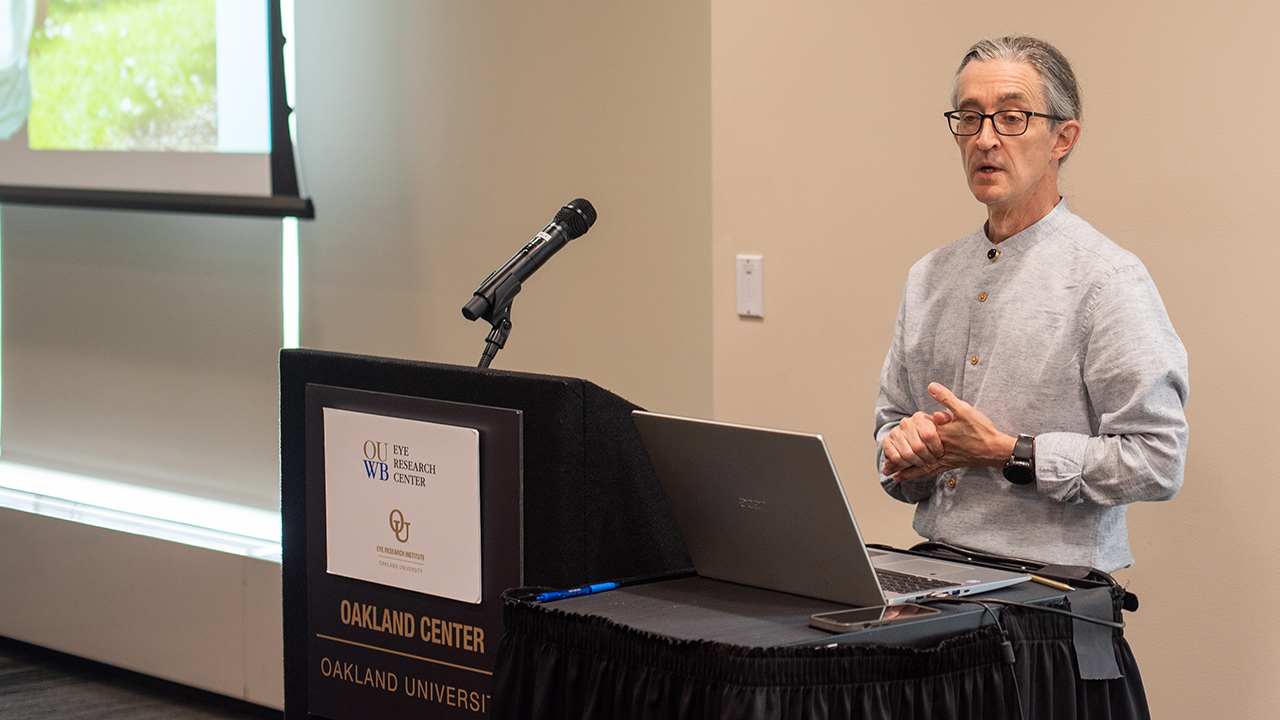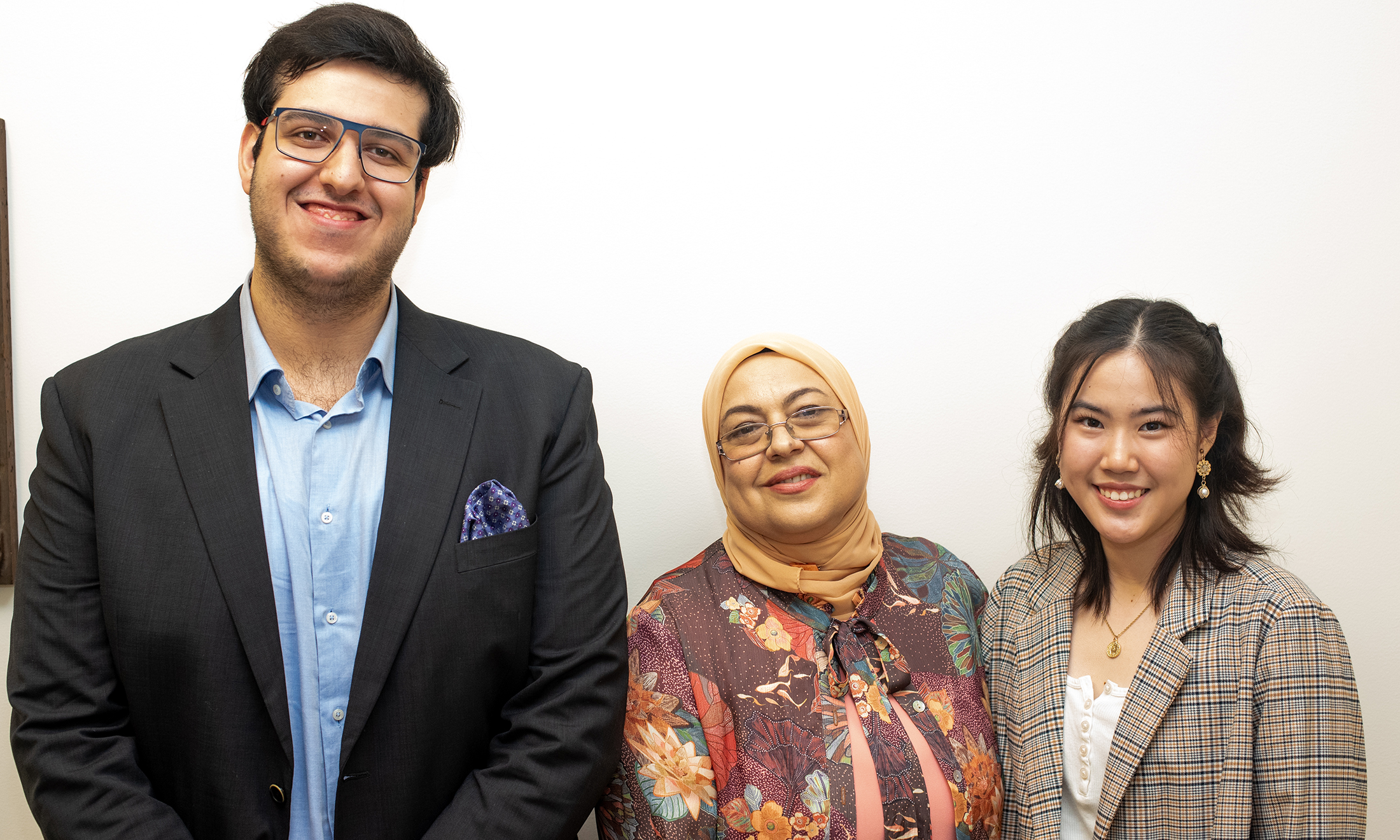OU students share eye research at 21st annual ERI SUPER Symposium

The Summer Undergraduate Program in Eye Research (SUPER) at Oakland University held its 21st annual student research symposium in the Oakland Center this summer.
“The Summer Undergraduate Program in Eye Research is a 12-week research experience program where students learn more detail about the eye than is taught in typical medical schools, and where they participate in externally funded research projects run by Eye Research Institute (ERI) faculty,” said Dr. Kenneth Mitton, associate professor of biomedical sciences and ERI faculty member. “This year, we had eight OU undergraduate students complete the program — the most since 2013.”
Using the latest scientific methodologies and equipment, the students spent 30 hours per week conducting lab experiments and attending a weekly Vision Science seminar given by ERI and Beaumont Ophthalmology faculty. The students also received a research fellowship, as well as training in professional speaking and presentation.
This year’s SUPER students include:
• Jennifer Jaster, who is pursuing a Bachelor of Science (BSc) degree in biochemistry with a minor in nutrition. Jaster was mentored by Dr. Mohamed Al-Shabrawey and Dr. Colin Wu.
“For my project this summer I worked to express and purify GPR31 and GPR39, which are two different membrane proteins,” Jaster said. “Then, I measured the binding affinities of those proteins to two different ligands, 12-HETE and 15-HETE, using a method known as ITC (Isothermal Titration Calorimetry).
“I find it fascinating that proteins each have their own structure, fold together in a particular way, and then react with a specific molecule to complete a function,” Jaster added. “The interactions I analyzed occur simultaneously with tons of other reactions to create effects at the large scale, which in this case means symptoms of diabetic retinopathy. I find it amazing that countless different interactions such as this occur without us even being conscious of it. Analyzing these interactions helps us to understand the mechanisms behind the different interactions, which could help create medicine or just increase our understanding of how we function at the molecular level.”
• Adam Schmitz, who is pursuing a BSc degree in biomedical sciences. Schmitz was mentored by Dr. Dao-Qi Zhang.
“The research I conducted in this year's SUPER as part of Dr. Zhang’s lab involved the disease Retinopathy of Prematurity (ROP),” Schmitz said. “Retinopathy Of Prematurity is associated with abnormal vascular growth in premature infants' retina, leading to problems in visual acuity. To study this human pathology, we used Oxygen Induced Retinopathy (OIR) in a mouse model. By using a control mouse subjected to only room air and an Oxygen Induced Retinopathy mouse subjected to an increased amount of oxygen following birth we were able to then track the changes of vasculature in mice.
“In the future I hope to become an Ophthalmologist to improve upon the life quality of individuals in my community, and being provided the opportunity to explore Ophthalmic research my first year at Oakland University has been a major stepping stone towards that goal,” Schmitz said. “Retinopathy of Prematurity has a vast amount of laser corrective surgeries but no current cure. Having this experience of a lifetime as a SUPER to explore this disease and help further efforts that will impact these ROP patients is truly an incredible feeling.”
• Victoria Jobczyk, who is pursuing a BSc degree in health sciences with a pre-health professional concentration. Jobczyk was mentored by Dr. Kenneth P. Mitton.
“My research in the SUPER program involved exploring the barrier formation of Human Retinal Microvascular Endothelial Cells (HRMEC) using a machine called ECIS (Electric Cell-substrate Impedance Sensing),” Jobczyk said. “In our first experiments, we seeded various cells per well (2,500, 5,000, and 36,000) to determine what quantity allowed us to visualize cell proliferation and gradual barrier formation best. In our following experiments, we used 2,500 cells per well to compare the effectiveness of varying doses of Norrin, resulting in a dose-response curve. In our final experiment, we used varying doses (20 ng/mL and 500 ng/mL) of Norrin and Noregen. Based on our results, Noregen appeared to stimulate HRMECs superior to the control, research-grade Norrin.
“This research personally interests me because Noregen has the potential to become a therapeutic treatment for patients with rare vascular eye diseases, such as Familial Exudative Vitreoretinopathy (FEVR),” Jobczyk said. “Currently, there are very limited treatment options for these patients and these vascular eye diseases are extremely debilitating. Having the opportunity to be a part of the team to create a new treatment possibility for these patients is an amazing and fulfilling feeling.”
• Omar Elzayat, who is pursuing a BSc degree in health sciences with a pre-health professional concentration. Elzayat was mentored by Dr. Amany Tawfik.
“In our lab, we are researching the effect of elevated levels of a specific amino acid called homocysteine, which is caused by a deficiency in vitamin B12, on the retina and how this can lead to Age-related Macular Degeneration (AMD) and Diabetic retinopathy (DR).,” Elzayat said.
“I found it interesting to learn various lab techniques and gain a deeper understanding of the pathology of eye diseases,” Elzayat added. “I found it also pleasurable to attend seminars that explored different medical research topics.”
• Michelle Tcherniak, who is pursuing a BSc degree in biomedical sciences. Tcherniak was mentored by Dr. Andrew Goldberg.
In our lab, we are studying inherited retinal disease by looking at photoreceptor cells of the retina,” Tcherniak said. “My research focused on visualizing proteins within these cells to better understand the pathophysiology of vision loss. Being interested in ophthalmology, it was fascinating to learn about the clinical applications of this research and very exciting to be involved in something I’m passionate about.”
• Cecille Pinnock, who is pursuing a BSc degree in bioengineering. Pinnock was mentored by Dr. Kenneth P. Mitton.
“My project was about customizing a cell-based assay system to test different FZD4 genetic variants for their ability to activate the Norrin WNT- Signaling Pathway,” Pinnock said. “Genetic variants of FZD4 are associated with very rare Pediatric Retinal Diseases. Also, Norrin WNT-Signaling Pathway is required for the growth of blood vessels in the retina. FZD4, LRP5 and a WNT signaling reporter gene were transfected into Human Embryonic Kidney Cells within a 24 well plate. Then, different doses of Norrin were placed within specific wells. Afterwards, the cells were lysed and collected. Once collected, the cells were tested using Luciferase Assay. This project enlightened me because having a FZD4 variant can affect the functioning of Norrin WNT-Signaling Pathway.”
• Morgan Carpenter, who is pursuing a BSc degree in biology. Carpenter was mentored by Dr. Mohamed Al-Shabrawey.
“Diabetic Retinopathy (DR) is a serious and common complication of diabetes,” Carpenter said. “Our lab is interested in discovering the molecular pathways which lead to the development of DR and exploring possible measures to prevent vision impairment caused by hyperglycemia.
“My project utilized retinal explants to study the effects of 12-HETE — a proinflammatory molecule that is upregulated as a result of hyperglycemia — on the neuronal and glial cells within the retina,” Carpenter added. “Our preliminary results suggest that 12-HETE negatively impacts the concentration of the neuronal cells and alters the metabolism of the cells found in the retina. As we continue to investigate the impact of 12-HETE on the retina, we will be able to further determine its role in DR.”
• Charlene Hsiung, who is pursuing a BSc degree in biochemistry. Hsiung was mentored by Dr. Amany Tawfik.
“The retina is part of the central nervous system and is actually an extension of the brain,” Hsiung said. “We have been evaluating the retina as a new site to study Alzheimer's disease, as well as the possible role that a compound called homocysteine may play in its onset. It has been shown that some retinal changes 'mirror' the changes we see in the brain during the progression of Alzheimer's, and these changes may be related or due to homocysteine. This disease is very hard to study, as the brain is incredibly complex, and in addition, research with the brain itself involves many risks, so if we can solidify this connection between the two areas, it may become easier to both predict and study the disease.
“This research is meaningful to me because so many people worldwide are have Alzheimer's; even more are affected by it, since caring for a patient with Alzheimer's places hefty emotional, financial, and physical difficulties on friends, families, and caretakers alike,” Hsiung added. “With the growing projection of cases in the future, it is becoming increasingly important to study the disease, how to treat it, and more significantly, how to predict it.”
Acceptance into the SUPER program is limited to OU students and is based on grades, a narrative, career goals, a reference letter and an interview with ERI faculty. Students learn the basics of research including how to keep a research notebook, problem solving, critical thinking, conducting literature searches and preparing a scientific talk. Approximately 75 percent of SUPER graduates go on to medical school or graduate school.
To apply for the program, students submit a personal narrative outlining career goals and interests, a letter of reference, academic transcripts and a resume. They are also interviewed by ERI faculty members.
Those admitted to the program receive a research fellowship of $4,250. Students also attend a weekly Vision Science seminar given by ERI and Beaumont Ophthalmology faculty and receive training in professional speaking and presentation.
To learn more about the Eye Research Institute at Oakland University, visit www.oakland.edu/eri.


 October 05, 2023
October 05, 2023







